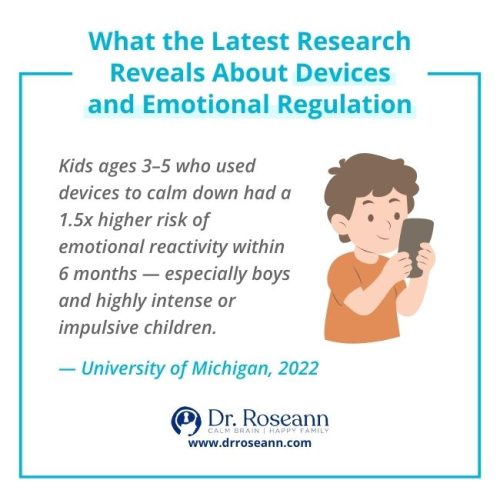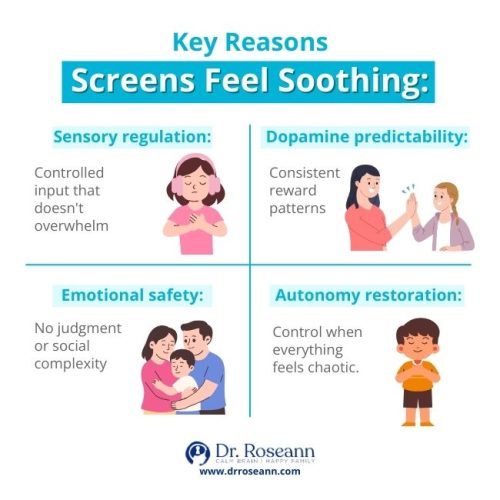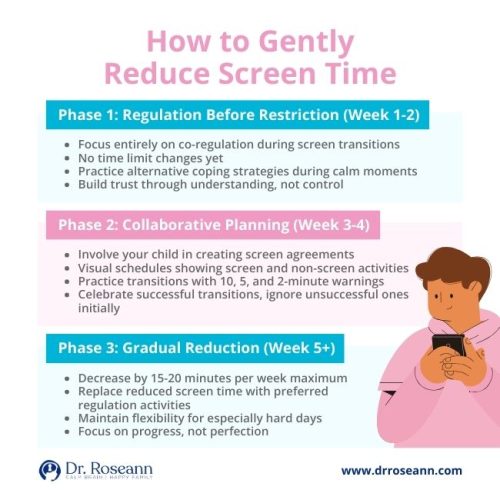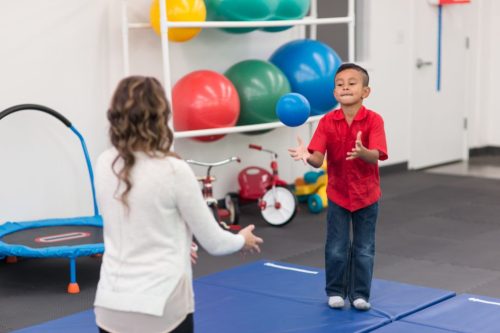Estimated Reading Time: 6 minutes
If screen time battles feel tough now, the next five years could bring anxiety, school refusal, and even addiction-level dependence.
Research shows that within just six months, frequent device use is linked to greater emotional reactivity, particularly in boys and children with big emotions and impulsivity.
The hard truth is that screens may calm in the moment but chip away at your child’s ability to self-regulate in the long run. Because screen addiction shows up differently in neurotypical and neurodivergent kids, solutions must be tailored.

Why Do Kids Turn To Screens For Comfort?
For dysregulated children, screens offer something their nervous system desperately craves: predictability and control. When their nervous system is in fight-or-flight, the digital world becomes a refuge where they can predict outcomes and experience success without real-world unpredictability.

Is Your Child Coping Or Avoiding?
There’s a fine line between healthy screen use as emotional breaks and problematic emotional avoidance. Understanding this distinction is crucial for parents.| Healthy Screen Coping | Problematic Screen Avoidance |
|---|---|
| Brief periods (20–30 minutes) after overwhelming experiences | First response to any emotional challenge |
| Smooth transitions away from screens | Meltdowns during transitions |
| Complements other coping strategies | Replaces all other coping mechanisms |
The Emotional Escape Red Flags:
- Reality rejection: “I only feel good when I’m gaming”
- Emotional numbing: Loss of interest in other activities
- Relationship withdrawal: Preferring digital over family time
- Mood dependency: Extreme swings tied to screen access
Signs Your Child Is Using Screens to Numb Out
Recognizing when your child has crossed from healthy screen use to emotional dependency requires looking at behavioral patterns and emotional responses.
Recent research shows signs of addiction include “compulsive use or the uncontrollable urge” to return to screens despite negative consequences.
Observable Warning Signs
Emotional Indicators:
- Intense anxiety when screens are unavailable
- Explosive meltdowns during transitions
- Mood dependent on screen access
Behavioral Red Flags:
- Sneaking screen time or lying about usage
- Inability to self-limit despite agreements
- Abandoning responsibilities for screens
- Physical symptoms when screens are removed
Social Disconnection:
- Preferring digital relationships over real ones
- Withdrawal from family activities
- Loss of interest in non-digital hobbies
Maria, mother of 10-year-old Emma with anxiety: “Emma started having panic attacks if her tablet battery died. She couldn’t regulate emotions without that digital safety net.”
The Neurobiology of Screen Dependence
Research shows that excessive screen time can reduce social coping skills and trigger craving behaviors similar to substance dependence. Dr. Anna Lembke, author of Dopamine Nation, explains: “Digital stimulation hijacks the brain’s reward pathways, creating tolerance that demands more screen time for the same effect.”
This helps explain why removing screens cold turkey often backfires. When the brain relies on screens for dopamine, kids may show withdrawal—not defiance.
What this means for your family: To reduce screen use successfully, you must replace the regulation screens provide, not just remove them.
Why Screens Are So Addictive for Some Kids
Understanding the dopamine-screen addiction cycle helps explain why some children develop problematic relationships with technology.
For dysregulated kids, this brain-behavior cycle is particularly vicious:
The Addiction Loop:
- Trigger: Overwhelming emotion or stress
- Screen seeking: Brain craves dopamine relief
- Temporary relief: Short-lived emotional regulation
- Tolerance building: Need for longer screen time
- Withdrawal distress: Increased dysregulation when screens end
- Cycle repetition: Stronger screen-emotion association
The Dopamine Problem:
- Dysregulated brains have lower baseline dopamine
- Screens provide artificial dopamine surges
- Natural rewards feel insufficient
- Tolerance develops, requiring more stimulation

Dr. Russell Barkley, ADHD researcher: “Children with ADHD are particularly vulnerable to screen addiction because their brains are already seeking stimulation to maintain optimal arousal levels.”
Why Neurodivergent and Emotionally Sensitive Kids Depend on Screens More
Studies show individuals with ADHD may be at higher risk for screen addiction, and excessive screen time may exacerbate ADHD symptoms.
| Condition | Why Screens Appeal / Unique Risk Factors |
|---|---|
| ADHD and Screen Addiction | • Executive function challenges make self-regulation difficult • Dopamine deficiency makes screens especially rewarding • Hyperfocus tendencies can lead to hours of use • Constant stimulation maintains attention |
| Autism and Screen Dependence | • Sensory seeking/avoiding behaviors find screens regulating • Routine needs are met through predictable digital content • Social challenges make digital interaction feel safer |
| Anxiety and Emotional Sensitivity | • Predictable environments reduce anxiety • Control mechanisms provide feelings of safety • Immediate emotional numbing during overwhelm |
Rebecca, mother of 12-year-old Sam with ASD: “Sam’s tablet became his everything. When I tried to limit it, his anxiety skyrocketed because I was taking away his primary coping tool.”
Dr. Roseann’s Therapist Quick Tip
In my 30+ years of clinical practice, I’ve learned that you can’t regulate a child who doesn’t feel safe. Here’s what I tell parents struggling with screen addiction: The biggest mistake is focusing on screen removal before addressing the underlying nervous system dysregulation that drives the dependence.
Try this today: Before any screen transition, spend 5 minutes doing co-regulating activities—deep breathing together, gentle movement, or sensory input like a warm hug or fidget toy.
Why it works: When a child’s nervous system feels supported and regulated, their brain is more capable of handling the transition away from screens without fight-or-flight activation.
Remember: Screen addiction is a nervous system problem disguised as a behavior problem. Calm the brain first, then address the behavior. It’s gonna be OK.
Healthier Ways For Kids To Cope Without Screens
The key to reducing screen dependence isn’t elimination—it’s replacement. Dysregulated children need alternatives that provide the same nervous system regulation.
Nervous System-Based Alternatives:
For Sensory Regulation:
- Heavy work: Wall pushes, carrying items, jumping
- Tactile input: Stress balls, textured materials
- Movement: Swinging, spinning, rocking
For Dopamine Regulation:
- Music and rhythm: Drumming, dancing
- Creative expression: Art, building, crafting
- Physical achievement: Sports skills, obstacle courses
For Emotional Safety:
- Cozy spaces: Reading nooks, soft lighting
- Predictable routines: Visual schedules, transition warnings
- Connection rituals: Special one-on-one time
Building Replacement Strategy:
- Identify screen function: What regulation need does it meet?
- Match intensity: Alternative must provide similar input
- Start small: 10-15 minute alternatives first
Tommy’s story:
9-year-old Tommy with ADHD had daily meltdowns over screen limits. His parents created a “regulation station” with a mini trampoline and fidget toys. Within two weeks, Tommy chose the station over screens 70% of the time.

How to Gently Reduce Screen Time Without a Fight
The secret to successful screen reduction with dysregulated kids isn’t stricter limits—it’s strategic nervous system support during transitions and gradual, collaborative changes.
The Gentle Reduction Framework:
Phase 1: Regulation Before Restriction (Week 1-2)
- Focus entirely on co-regulation during screen transitions
- No time limit changes yet
- Practice alternative coping strategies during calm moments
- Build trust through understanding, not control
Phase 2: Collaborative Planning (Week 3-4)
- Involve your child in creating screen agreements
- Visual schedules showing screen and non-screen activities
- Practice transitions with 10, 5, and 2-minute warnings
- Celebrate successful transitions, ignore unsuccessful ones initially
Phase 3: Gradual Reduction (Week 5+)
- Decrease by 15-20 minutes per week maximum
- Replace reduced screen time with preferred regulation activities
- Maintain flexibility for especially hard days
- Focus on progress, not perfection
Transition Strategies That Work:
| Transition Phase | Strategies That Work |
|---|---|
| Before Screen Time | • “First we regulate, then we play” • 10 minutes of focused connection before screens • Set clear expectations with visual timers • Plan the transition activity in advance |
| During Transitions | • Co-regulate first: “I can see this is hard. Let’s breathe together.” • Validate feelings: “You wish you could play longer. That makes sense.” • Offer choices: “Would you like to save your game or have me help?” • Stay calm—your nervous system regulates theirs |
| After Screen Time | • Provide immediate regulation support (don’t leave them alone) • Offer physical connection: hugs, back rubs, sitting close • Avoid behavior discussions during dysregulated moments • Reconnect by showing interest: talk about their game |
Lisa’s transformation: “Once I stopped fighting with my ADHD son about screens and started supporting his nervous system during transitions, the battles disappeared. Now he often ends screen time early because he feels safe enough to do other activities.”
Dr. Stuart Shanker, a leading expert on self-regulation, explains: “The goal of self-regulation isn’t to enforce compliance, but to help children recognize their physiological and emotional states and give them the tools to manage those states effectively.”
Breaking Free from Screen Dependence with Compassion
Screen addiction is not bad parenting; it is a child’s nervous system seeking regulation. Once we see it this way, solutions become clearer.
The path forward:
- Calm the nervous system before restricting screens
- Offer alternative regulation strategies that meet the same needs
- Use co-regulation and patience during transitions
- Build coping skills gradually
Remember: behavior is communication. Screen dependence is your child’s way of saying, “I need help regulating.” When we respond with compassion instead of punishment, everything shifts.
You are not alone. With the right tools, your child can develop a healthier relationship with both screens and emotions.
FAQs
How long does it take to break screen addiction in dysregulated kids?
Most families see progress in 6–8 weeks. Kids with ADHD, autism, or trauma may need 3–4 months of consistent support.
Is it ever okay to go “cold turkey” with screens?
Cold turkey often backfires, removing a coping tool without alternatives. Gradual reduction with regulation support works better.
How do I handle screen addiction if my child has both ADHD and anxiety?
Use dual strategies—activities that offer stimulation and safety, like rhythmic movement, creative arts, or structured exercise.
Should I be concerned about my 5-year-old’s screen use?
Yes, if daily use exceeds 2 hours or your child shows distress in transitions, lies about use, or avoids non-screen play.
What’s the difference between screen limits and addiction treatment?
Screen limits control behavior. Treatment addresses emotional and neurological needs with regulation, replacement activities, and nervous system support.
Citations
Christakis, D. A. (2019). The challenges of defining and studying “digital addiction” in children. JAMA, 321(23), 2277–2278. https://doi.org/10.1001/jama.2019.4690
Domingues-Montanari, S. (2017). Clinical and psychological effects of excessive screen time on children. BMJ Paediatrics Open, 1(1), e000123. https://doi.org/10.1136/bmjpo-2017-000123
Lissak, G. (2018). Adverse physiological and psychological effects of screen time on children and adolescents: Literature review and case study. Environmental Research, 164, 149–157. https://doi.org/10.1016/j.envres.2018.01.015
Radesky, J. S., Weeks, H. M., Schaller, A., Burrows, C., & Heberle, A. E. (2022). Digital device use to soothe young children and associations with emotional reactivity. JAMA Pediatrics, 176(12), 1223–1231. https://doi.org/10.1001/jamapediatrics.2022.4363
Twenge, J. M., & Campbell, W. K. (2018). Associations between screen time and lower psychological well-being among children and adolescents: Evidence from a population-based study. Preventive Medicine Reports, 12, 271–283. https://doi.org/10.1016/j.pmedr.2018.10.003
Always remember… “Calm Brain, Happy Family™”
Disclaimer: This article is not intended to give health advice and it is recommended to consult with a physician before beginning any new wellness regime. *The effectiveness of diagnosis and treatment vary by patient and condition. Dr. Roseann Capanna-Hodge, LLC does not guarantee certain results.
Are you looking for SOLUTIONS for your struggling child or teen?
Dr. Roseann and her team are all about science-backed solutions, so you are in the right place!
©Roseann Capanna-Hodge









